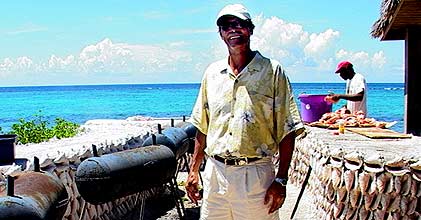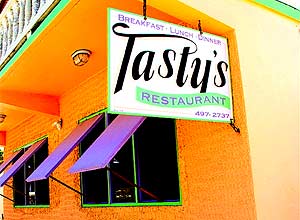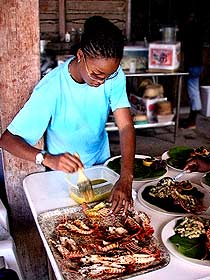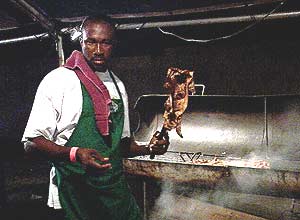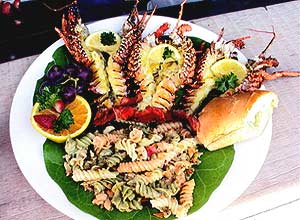By Paul Ross
Recipes:
Fish Steaks with “Secret”
Scilly Cay Grilling Sauce
Grilled Chicken Parts with
Tasty’s Barbecue Sauce
Caribbean “Crayfish” with
Tasty’s Wet Rub
Anticipating my next thought, he continued, “It ain’t the meat neither. Nor the smoke, nor the temperature. None of them things you’ve been told–ha!””Some say the secret of great barbecue is the sauce,” winked the grizzled old sailor, “but it ain’t so.”
Maybe it was the tropical humidity or the anticipation, but sweat trickled down my cheek as he took time to relight his pipe before concluding a tale that had rendered the normally rowdy waterfront saloon silent.
In a flash, he reached into his pocket and tossed a wrinkled and stained parchment down on the table, motioning me to open it. It was a map or, more properly, a sea chart. Tapping at a tiny spot mid-Caribbean, he leaned over and winked again, confidentially.
“On-GEE-yah?” I attempted in my best half-assed New Mexican Spanish.
“An-GWIL-lah,” he corrected. Sounds like somethin’ Godzilla fought with, don’t it? But it’s a coral isle, just sixteen by three miles. Near St. Martin, it is, so recently, them tourists have ‘discovered’ it. Warm, sunny skies, clear blue water, purty beaches, some trendy restaurants and hotels. But only the natives know its real treasure.”
“Barbecue?” I ventured (remembering the beginning of the conversation that he’d obviously forgotten in his rum-soaked stupor).
His only response was yet another coy wink which confirmed my guess. With that, he passed out, pitched forward onto the table and commenced snoring. I slipped the map out from under his hand and quickly hastened into the night, checking to make sure that I wasn’t being followed.
A day later, I was on Anguilla and on the trail of a Caribbean barbecue secret shrouded in myth. Yes, there were the world-famous, deluxe resort hotels that the old salt had alluded to: Cap Juluca, Malliouhana, Frangipani, Sonesta, Cove Castles, and CuisinArt. Each had incredible food but much of it was Continental, some even flown in from France. And the unspoiled beaches were a diverting temptation, but I kept to my mission. Fortunately, the language was English (Anguilla is a British Overseas Territory) and helped my search as I asked every local I could about barbecue. Finally, I got a break.
“Go to the boat races,” a woman said off-handedly, “You may be surprised at what you’ll find there.”
Boat racing is the national sport and, during the annual Summer Festival, it’s conceivable that the entire population (about 10,000 people) crowds onto the beach to cheer on their favorites. And eat barbecue.
Black steel charcoal-fueled grills lined the beach, filling the sea air with pungent sweetness. Ribs and chicken were the order of the day and I had several orders of each. Both meats were crunchy to the tooth while being tender and juicy on the inside. Sometimes sauces were store-bought, commercial products poured straight from the bottle but that didn’t matter. There was something very special about the flavor, something unique and not quite definable. I asked again and again about why that was–but only received friendly smiles in reply.
Taking pity on me, one boat reveler offered, “It’s the atmosphere!”
That night, I tested the theory by attending an entirely different type of party. No sun, no beach, no boats –just music. After rigorous competition, “The Leeward Islands Calypso King” was going to be crowned. Again the air was redolent with rich barbecue smoke. Under cover of darkness, I crept to one of the food tents for a close look. As a heaping tray of chicken and ribs was hauled away toward a throng of hungry customers, I noticed the glowing coals underneath. They were not compressed, even, uniform pieces but were oddly-shaped and still-recognizable lumps of blackened wood. Could that be “it?” Something that simple, that basic, was responsible for such incredible flavor!?
|
|
Gorgeous himself at the grill
|
The next day, I was in a small launch on my way out to a spit of land in the midst of placid Island Harbor. The Scilly Cay (pronounced “silly key”) restaurant has a limited but legendary menu: lobster, chicken, snapper, crayfish and a rum punch that deserves its name. The owner, “Gorgeous,” took me on a kitchen tour. I saw the now-familiar black grills outside on the beach. Crayfish as big as lobsters and lobsters as grand as great white sharks graced the grill as opportunity-seeking gulls hovered overhead. Even allowing for “the secret Scilly Cay sauce,” the seafood presented that same ineffable Anguillan wonderfulness.
|
|
With crayfish and lobster on
|
This time, I approached the mystery head-on.
“Where do you get your charcoal?” I asked bluntly.
“From an old man,” Gorgeous grinned.
“Aha!” I thought, “Home-made. Now I’ve got my first solid clue.”
The following afternoon at Tasty’s island-style restaurant, an entrepreneur/chef validated my suspicion.
“Not that many people still make charcoal anymore,” sighed Dale Carty. “It is the best for barbecue.”
Sensing my enthusiasm for this aspect of local culture, he took me around back. There, a pile of mixed sand, ash, and burnt wood still lightly smoldered.
“Ooh, too bad,” he exclaimed. “He pulled down the keel.”
Later, I learned the rest of the secret from the reminiscences of two Anguillan elders: “Brod” (“brode”), a personable guide and driver, and Alan Gumb, owner of the venerable Rendezvous Bay Hotel.
|
|
The colorful but simple exterior of one
|
Indigenous hardwoods, particularly seagrape, tamarind, cedar, and wild mango, are cut and dried for three days. According to them , each wood has different qualities “like wine and cigars.” Next, the dried wood is stacked high in a specific way. Sometimes, cord is wound around the base load against which the rest of the stack is piled. It has to be dense enough to maintain structural integrity and hold in the heat but open a crack at the bottom to allow a flow of air to keep the fire going. “Coal Keel” is an island corruption of the world “kiln.” Once the stack is completed, it’s covered with damp seaweed or moist green leaves and “dig dirt,” except for a small hole at the top to let smoke escape and sustain an air draw. The keel is set alight and, depending on its size, left to burn for around three to five days. “It’ll fall down a little bit,” says Brod, “but a trained eye will judge the smoke and know when to add dirt or water, when to tamp it and when to pull it down.”
|
|
Traditional Anguillan
|
As the old-time skills and the time to employ them are being lost, those who still craft charcoal are asking premium prices for their work. And most Anguillans, who appreciate good barbecue, are willing to pay for it.
I’m just grateful to an old sailor who’d had a little too much to drink for access to a delicious secret.
If You Go:
There are direct flights on American Eagle from San Juan, Puerto Rico. Or you can fly to St. Martin, and take a fifteen minute ferryboat ride over to Anguilla.
Anguilla Tourist Board 1-800-553-4939, www.anguilla-vacation.comMore information available at www.caribseek.comHotels, resorts and villas: Be sure to ask about special packages like two rooms for the price of one, or “girl-friend” (women only) holidays.
Accommodations
Super luxury:
-
Tenemos: 264-222-9000 or www.tenemosvillas.com
-
Covecastles: 1-800-223-1108 or covecastles@anguillanet.com
Luxury:
-
Malliouhana: 1-800-835-0796 or www.malliouhana.com
-
Cap Juluca: 1-888-858-5822 or webmaster@capjuluca.com
-
CuisinArt: 1-800-943-3210 or www.cuisinartresort.com
Medium Priced:
-
Frangipane: 1-800-892-4564 or www.frangipani.ai
-
Rendezvous Bay: 264-497-6549 or rendezvous@anguillanet.com
Affordable:
-
Arawak: 1-877-27-2925 or www.arawakbeach.com (doubles start at $95 low season and $175 high season).
Restaurants
Pricey:
-
Cap Juluca (their crayfish are great)
-
Malliouhana (try their artichoke appetizer and enjoy the view from the terrace)
-
CuisinArt (hydroponic food grown on premises)
-
Scilly Cay, 1-264-497-5123 or gorgeous@anguillanet.com
-
Altamer 1-264-498-4040
-
Medium:
-
Frangipane (French/Caribbean fusion)
-
Rendezvous Bay (try the lobster medallions and strawberry crème brulé)
-
Malliouhana Bistrot (for lunch–pool and beachside)
Affordable eats:
-
Outdoor festivals
-
Tasty’s Café: 1-264-497-2737 (killer curried goat stew)
-
E’s Oven: 1-264-498-8258
There’s even the chance to swim with dolphins at Fantaseas 264-497-7946 or www.dolphinfantaseas.com
Recipes
Note: When I made a noble attempt to collect Anguillan grilling recipes, the chefs were very cooperative in giving me the ingredients, but not forthcoming about ingredient amounts or instructions. “I just t’row it together, mon,” was a typical comment. So when I got back to New Mexico, I went over to editor Dave DeWitt’s house and we developed the following recipes based on my brief notes. After tasting the results, I can attest that they are a reasonable facsimile of what I feasted on in Anguilla.
Fish Steaks with “Secret” Scilly Cay Grilling Sauce
Gorgeous insists that his sauce is secret, but if he wanted to keep it that way, he should never have told me the ingredients. We experimented in Dave’s and Mary Jane’s kitchen until we got the sauce right. It can also be used on chicken. It is a grill sauce, designed to be brushed on during the grilling process, but it has a lot of sugar in it, so take care that it does not burn. The sauce yield is about 1 cup.
|
|
Paintin’ on Scilly Cay’s “secret sauce”
|
-
2 teaspoons olive oil
-
1 clove garlic, chopped
-
½ cup orange marmalade
-
1 cup orange juice
-
1 teaspoon Dijon mustard
-
1 teaspoon dried tarragon
-
1/4 teaspoon curry powder
-
1 tablespoon ground dry roasted peanuts
-
2 tablespoons Scotch bonnet or habanero hot sauce
-
1/4 teaspoon freshly ground black pepper
-
2 thick fish steaks, such as shark or tuna
In a sauce pan, heat the olive oil and saute the garlic. Add the remaining sauce ingredients and cook over medium heat until the sauce thickens, about 10 minutes. Transfer to a blender and puree until smooth. Transfer to a bowl and refrigerate if not using it immediately.
Add wood chips (such as pecan or mesquite) to the grill fire. Brush the sauce over the steaks and place them on the grill. Keep brushing the steaks with the sauce until they are done. The time will vary according to the heat of the fire, the thickness of the steaks, and their proximity to the fire. Try not to turn the steaks more than twice.
Yield: 2 servings
Heat Scale: Medium
Grilled Chicken Parts with Tasty’s Barbecue Sauce
The ingredients for this sauce were given to me by Dale Carty and I must say that I admired him for making his sauce from scratch rather than buying a commercial one. That’s probably why his restaurant is named as it is. This sauce is added to the chicken during the last half of cooking, and the chicken is best when it’s smoke-grilled (used wood chips soaked in water), so keep it quite a distance from the fire, close the lid on the barbecue unit, and grill it slowly. The sauce yield is about 3 cups or a little more.
|
|
They’re serious about BBQ in Anguilla
|
-
1 tablespoon olive oil
-
1 clove garlic, chopped
-
1 medium onion, chopped
-
1 green or red bell pepper, chopped
-
3 medium tomatoes, peeled and chopped
-
1 cup water
-
2 tablespoons mango chutney
-
1/4 cup pine nuts, dry roasted and ground
-
1 teaspoon thyme
-
1/4 cup Scotch bonnet or habanero hot sauce
-
1 medium chicken, cut into 8 pieces (2 wings, 2 thighs, 2 legs, 2 breasts)
In a large skillet over medium heat, saute the garlic in the olive oil for about 2 minutes. Add the onion and saute an additional 5 minutes. Add the pepper and saute another 5 minutes. Add the tomatoes and saute, covered for 20 minutes. Uncover, add the remaining sauce ingredients and simmer for 5 minutes. Transfer to a blender and puree.
Smoke grill the chicken until half done, brush the parts with the sauce, and continue smoke-grilling until done.
Yield: 4 servings
Heat Scale: Medium
Caribbean “Crayfish” with Tasty’s Wet Rub
I was served what the Anguillans call crayfish, but they’re considerably larger than the Louisiana kind yet smaller than a spiny lobster. Don’t ask me their scientific name. Substitute large lobster tails for them if they don’t live in your neighborhood. The wet rub or marinate is from Dale Carty at Tasty’s and it’s quite unique. The yield is about 1 cup.
|
|
A bounteous plate at Gorgeous’ Scilly Cay
|
-
1/2 cup freshly chopped basil
-
1 1/2 inch long piece of ginger, peeled and grated
-
1 teaspoon dried oregano
-
1 teaspoon thyme
-
1/4 cup olive oil
-
2 tablespoons Scotch bonnet or habanero hot sauce
-
2 large lobster tails, removed from the shell
In a bowl, combine all the ingredient for the rub. Add the lobster tails to the rub and coat well. Marinate for at least one hour in the refrigerator. Grill over medium heat for about 7 to 8 minutes a side, turning once. You will have to re-coat the tails with the rub when they are on the grill.
Yield: 2 servings
Heat Scale: Medium
Story and Photos by Paul Ross






